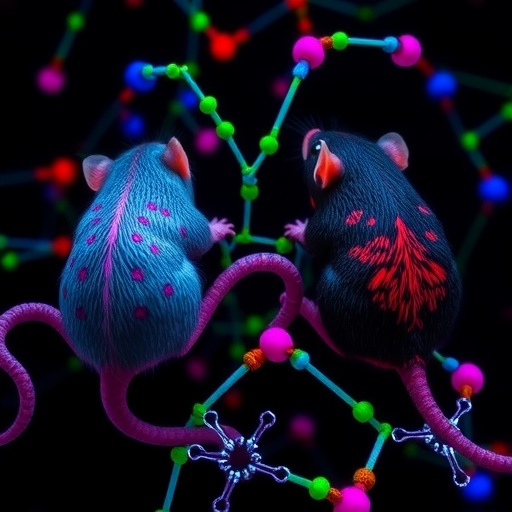In a groundbreaking study that could reshape our understanding of neurological sex differences, researchers have delved into how noradrenergic signaling regulates the medial prefrontal cortex (mPFC) in mice. Conducted by an accomplished team including Scroger, M.V., Athanason, A.C., and Paperny, N.M., this research represents a significant leap in neuroscience, opening new avenues for investigating gender-specific responses to medication and potential treatments for psychological disorders.
The medial prefrontal cortex is crucial for a variety of cognitive and emotional functions including decision-making, self-regulation, and emotional responses. This brain region is also known for its role in social behaviors, making it particularly significant in understanding the biological underpinnings of human interactions. Previous studies indicated potential variations in this area between sexes, but detailed explorations of how these variations manifest at the molecular level were lacking until now.
The researchers utilized a cohort of genetically similar mice, enabling them to control for extraneous variables. By doing so, they were able to isolate the effects of sex on noradrenergic signaling specifically within the mPFC. This approach is critical because it allows for a more focused investigation into how male and female brains may operate differently under similar pharmacological conditions. The noradrenergic system, primarily involving norepinephrine, is known to influence a range of physiological processes including attention, stress response, and arousal.
One of the most striking findings from the study was the differential expression patterns of noradrenaline receptors in male and female mice. The research team discovered that female mice exhibited higher receptor density in the mPFC compared to their male counterparts. This raises intriguing questions about how these differences may affect behavioral responses and cognitive processing, particularly in relation to stress and emotional regulation. Given that females are often found to be more susceptible to anxiety disorders, this research underscores the need for sex-specific considerations in treatment strategies.
Neuroscientists have long theorized that sex hormones could modulate brain circuits, but the present study takes this a step further by showcasing the direct implications of noradrenergic regulation on brain structure and function. The implications are profound for understanding the neurobiological basis of gender differences in mental health conditions. For instance, variations in stress response may be linked to how norepinephrine is utilized in the brain, with females potentially exhibiting heightened responses that could contribute to increased anxiety or depression.
In addition to exploring receptor density, the researchers investigated the signaling cascades activated by norepinephrine within the mPFC. By using advanced imaging techniques, they were able to observe real-time changes in neural activity in response to noradrenergic stimulation. The results indicated that females exhibited a more robust activation pattern in response to norepinephrine, suggesting a heightened sensitivity that could explain their differential emotional responses compared to males.
This discovery underscores the complexities involved in neurotransmitter systems and their role in modulating behavior. It emphasizes the need for personalized approaches in treating psychiatric conditions. As researchers delve deeper into these biological differences, it may become increasingly clear that treatments should be tailored not just to the disorder itself, but also to the sex of the patient. This study provides a strong foundation for further investigations into sex-specific mechanisms, encouraging more inclusive and effective therapeutic strategies.
Moreover, the implications extend beyond the laboratory. Understanding how sex differences in the mPFC can influence behaviors and emotional processing could have far-reaching effects on public health initiatives. As society continues to confront growing mental health challenges, integrating knowledge about biological differences into treatment paradigms could improve outcomes significantly. This research sets the stage for future studies that could apply these findings in clinical settings.
As science increasingly acknowledges the importance of gender differences in biomedical research, the findings from this study may prompt a shift in how scientists approach the investigation of psychiatric disorders. Considering the fundamental biological differences could lead to breakthroughs that were previously overlooked. The field of psychology stands to benefit immensely from a nuanced understanding of how sex influences brain function.
In light of these revelations, the complexity of biological programming becomes evident. The researchers hope that their findings will inspire further studies that investigate how environmental factors, such as stressors or hormonal fluctuations throughout various life stages, may interact with established noradrenergic pathways. The possibility of integrating environmental science with neuroscience could lead to a more holistic understanding of both brain structure and emotional health.
While this study presents exciting prospects for future research, it also opens discussions about ethical considerations in animal research. The study employed best practices for conducting research on animal subjects, underscoring the importance of ethical standards in scientific inquiry. Ensuring humane treatment while obtaining crucial insights into brain functioning remains one of the pillars of responsible scientific research.
As knowledge in this area expands, there may be a push for similar studies utilizing human participants as well. If the patterns observed in mice translate to humans, we could see a paradigm shift in how psychiatric treatments are approached for men and women, ultimately leading to more tailored and effective interventions for mental health issues.
In conclusion, the publication of these findings marks a pivotal moment in understanding the biological intricacies influencing mental health—a field where sex differences have been historically underexplored. As the scientific community digests the implications of this research, we can anticipate a burgeoning interest in investigating how other neurotransmitter systems may also be influenced by biological sex. The research team’s findings beckon a wave of future studies that could illuminate the critical role of sex in shaping not just brain function but the behavioral manifestations of both psychological well-being and dysfunction.
Subject of Research: Neurological sex differences in noradrenergic regulation of the medial prefrontal cortex.
Article Title: Sex differences in noradrenergic regulation of the medial prefrontal cortex in mice.
Article References:
Scroger, M.V., Athanason, A.C., Paperny, N.M. et al. Sex differences in noradrenergic regulation of the medial prefrontal cortex in mice.
Biol Sex Differ 16, 97 (2025). https://doi.org/10.1186/s13293-025-00779-4
Image Credits: AI Generated
DOI: https://doi.org/10.1186/s13293-025-00779-4
Keywords: Noradrenergic signaling, medial prefrontal cortex, sex differences, neuroscience, mental health, behavior, anxiety, depression, neurotransmitters.
Tags: cognitive and emotional functions in neurosciencegender-specific responses to medicationgenetic control in neurobiologymedial prefrontal cortex functionsmolecular variations in brain regionsneuroscience research and gender studiesnoradrenergic signaling in micepharmacological conditions in neurosciencepsychological disorders and treatmentssex differences in brain functionsex-based neurochemical differencessocial behavior and brain function





